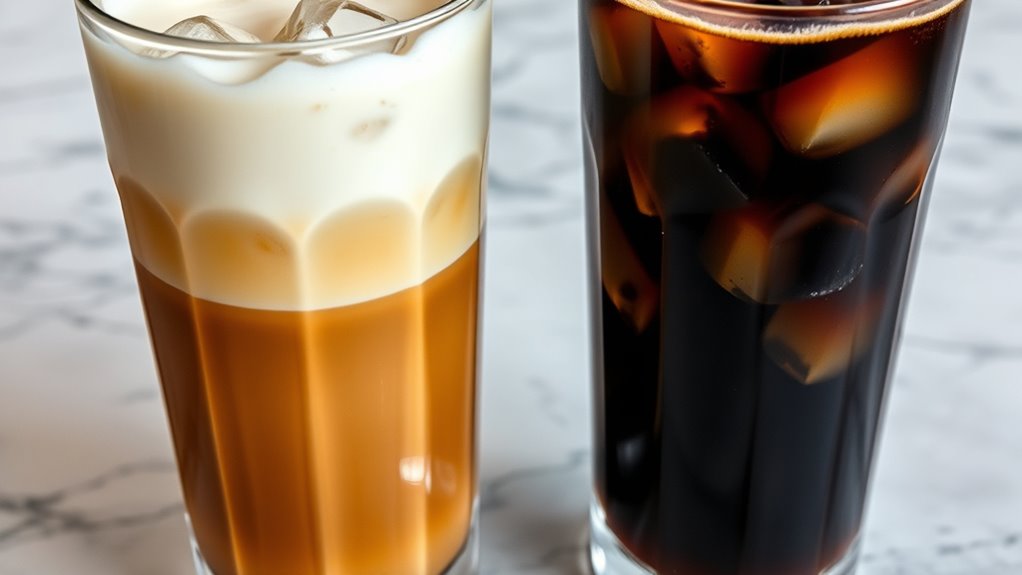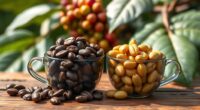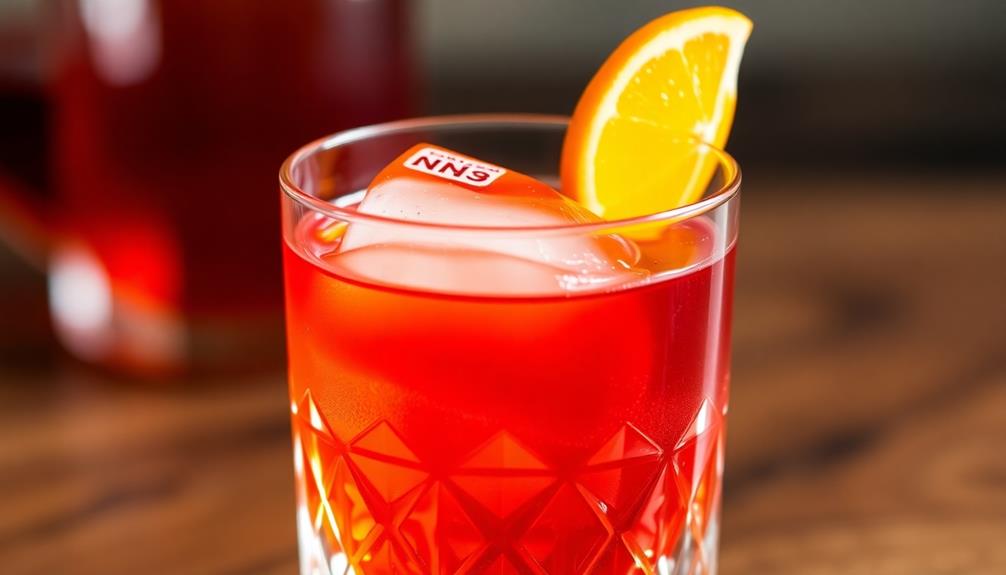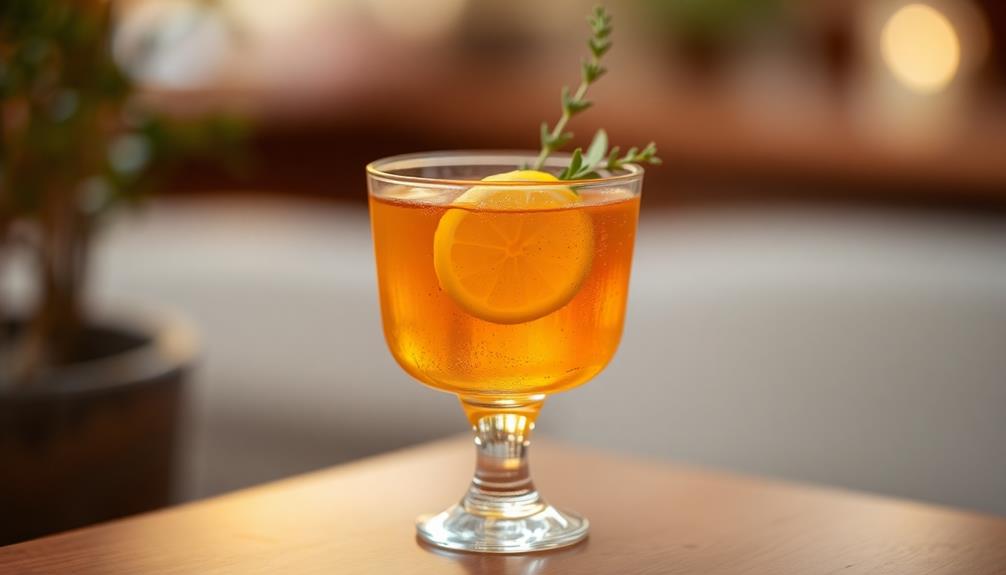Iced lattes start with brewed espresso poured over milk and ice, giving you a smooth, creamy, and balanced flavor with moderate caffeine. Cold brew, however, involves steeping coarsely ground coffee in cold water for hours, resulting in a strong, full-bodied, and less acidic drink with higher caffeine levels. While iced lattes are light and invigorating, cold brew offers a richer, more concentrated experience. Keep exploring to discover all the subtle differences and tips for perfecting each!
Key Takeaways
- Iced lattes use quick espresso extraction and milk for a smooth, creamy, and refreshing experience, while cold brew involves slow steeping for a full-bodied, velvety texture.
- Cold brew generally has a higher caffeine concentration and a richer, more concentrated flavor compared to the lighter, balanced profile of iced lattes.
- Iced lattes are typically lower in caffeine per serving, with added sweetness and milk, whereas cold brew is often served black or with flavor infusions for a bolder taste.
- Presentation differs: iced lattes are visually layered with foam and garnishes, while cold brew has a darker, more concentrated appearance, often served over ice.
- Both drinks are highly customizable with syrups, spices, or milk alternatives, but cold brew’s extended steeping process allows for more flavor infusion and versatility.
Brewing Methods and Preparation Techniques

When it comes to brewing iced lattes and cold brews, the preparation techniques differ markedly. For iced lattes, you start with brewing espresso using quality brewing equipment like a sturdy espresso machine or AeroPress. Once brewed, chill the espresso quickly to prevent over-extraction, then pour it over ice. Ingredient sourcing is essential here—use fresh, high-quality coffee beans for rich flavor. Cold brew, on the other hand, requires steeping coarsely ground coffee in cold water for 12 to 24 hours, often in a large jar or cold brew maker. This method demands different brewing equipment, such as a French press or dedicated cold brew pitcher. Good ingredient sourcing for cold brew involves selecting beans with bold, smooth profiles to withstand the longer steeping process. Additionally, incorporating elements like natural materials such as wooden or ceramic filters can enhance the brewing experience and flavor extraction.
Flavor Profiles and Taste Differences
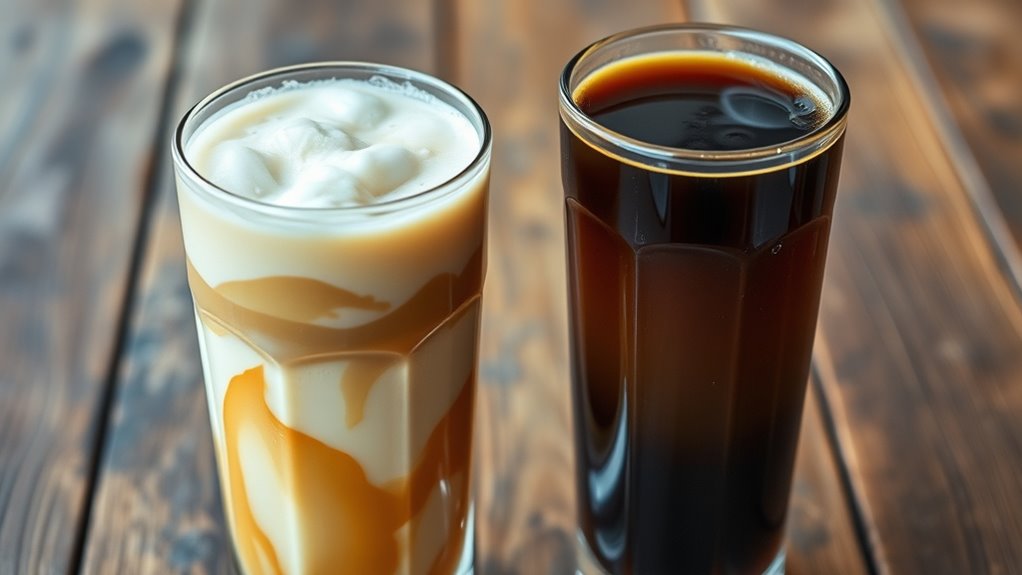
You’ll notice that iced lattes tend to have a smoother, creamier flavor with balanced sweetness, while cold brews often deliver a bolder, more intense taste. The differences in acidity also stand out, with cold brew usually being less acidic and more mellow. These variations shape how you experience each drink’s unique flavor profile.
Flavor Intensity Variations
The flavor intensity of iced lattes and cold brews varies considerably due to their different brewing methods and ingredient profiles. Cold brew’s slow extraction results in a smoother, often more concentrated flavor, giving you a richer and bolder taste. Iced lattes, on the other hand, tend to be lighter, with the milk or milk alternatives diluting the coffee’s strength. If you prefer a more intense flavor, you might add flavor enhancements like syrups or spices to your latte. Using milk alternatives such as almond, oat, or coconut milk can also impact the overall flavor profile, either mellowing or amplifying different notes. Ultimately, your choice influences how robust or subtle the coffee’s taste feels, making flavor intensity a key factor in selecting your preferred brew. Additionally, considering different craft and textiles techniques can inspire creative ways to customize your coffee presentation or accessories.
Sweetness and Acidity
While flavor intensity focuses on strength and boldness, sweetness and acidity shape the coffee’s overall taste balance. Your experience with iced lattes and cold brews depends heavily on these flavor profiles. Here are four key points to contemplate:
- Sweetness levels vary between drinks, with cold brew often tasting smoother and less sweet unless added.
- Iced lattes tend to have a natural sweetness from milk, balancing the coffee’s acidity.
- Cold brew’s lower acidity provides a mellow, less tangy taste, appealing if you prefer a subtle flavor.
- Adjusting sweetness and acidity balance can personalize your drink, whether you like it more vibrant or smooth.
- Knowing how different brewing methods influence flavor profiles can help you choose the perfect coffee for your palate, especially when considering coffee flavor profiles.
Understanding these differences helps you choose based on how much sweetness and acidity you want in your coffee experience.
Caffeine Content and Energy Boosts

When comparing iced lattes and cold brews, their caffeine content plays a crucial role in how energized you’ll feel. Cold brew typically has a higher caffeine concentration per ounce because it uses a longer extraction process, allowing for more caffeine to be dissolved. This means you get a stronger caffeine absorption with cold brew, leading to a more immediate energy boost. Iced lattes, made with espresso and milk, generally have less caffeine per serving, resulting in a milder but more sustained energy duration. Your body absorbs caffeine differently based on the drink’s concentration, affecting how quickly you feel energized and how long that feeling lasts. So, if you need a quick, potent jolt, cold brew might be your go-to, whereas an iced latte offers a steadier energy release. Additionally, concerns about AI vulnerabilities highlight the importance of monitoring and understanding the variables that influence caffeine absorption and energy effects.
Texture and Mouthfeel Variations
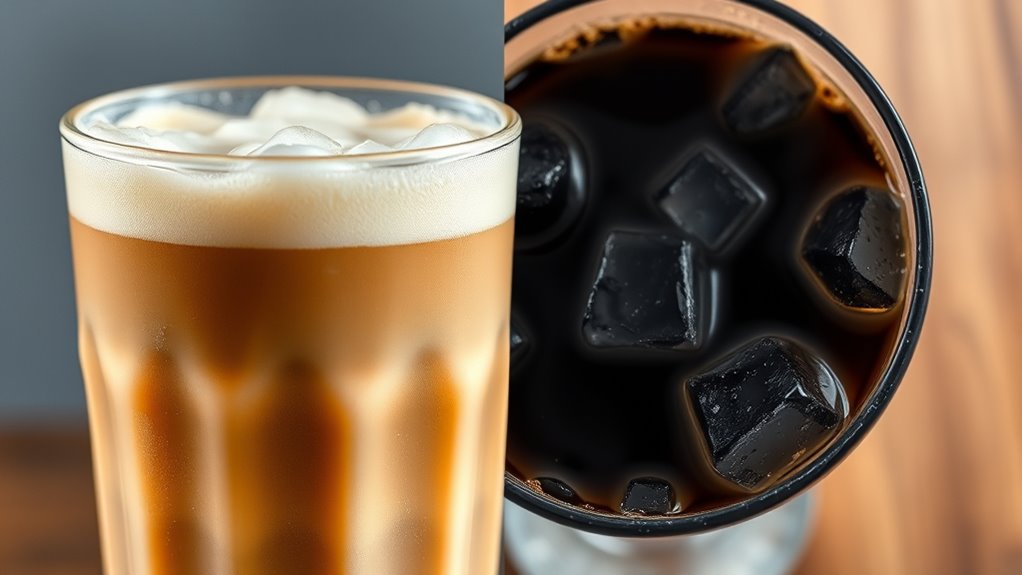
Cold brew often delivers a smooth, velvety texture that feels rich and full-bodied on your palate, thanks to its extended steeping process. This results in a creamy mouthfeel that enhances the overall drinking experience. In contrast, an iced latte typically offers a crisp texture with a lighter, more invigorating feel. Additionally, the brewing process of cold brew can influence its texture and mouthfeel, creating a uniquely thick and smooth sensation. Here are some key differences:
- Cold brew’s mouthfeel is thick and smooth, providing a luxurious sensation.
- Iced lattes tend to be lighter, with a crisp, clean finish.
- The cream or milk in a latte adds to its creamy mouthfeel, balancing the coffee’s robustness.
- Cold brew’s extended extraction can create a subtly syrupy or rounded texture.
Understanding these variations helps you choose based on your preferred sensory experience.
Serving Styles and Presentation
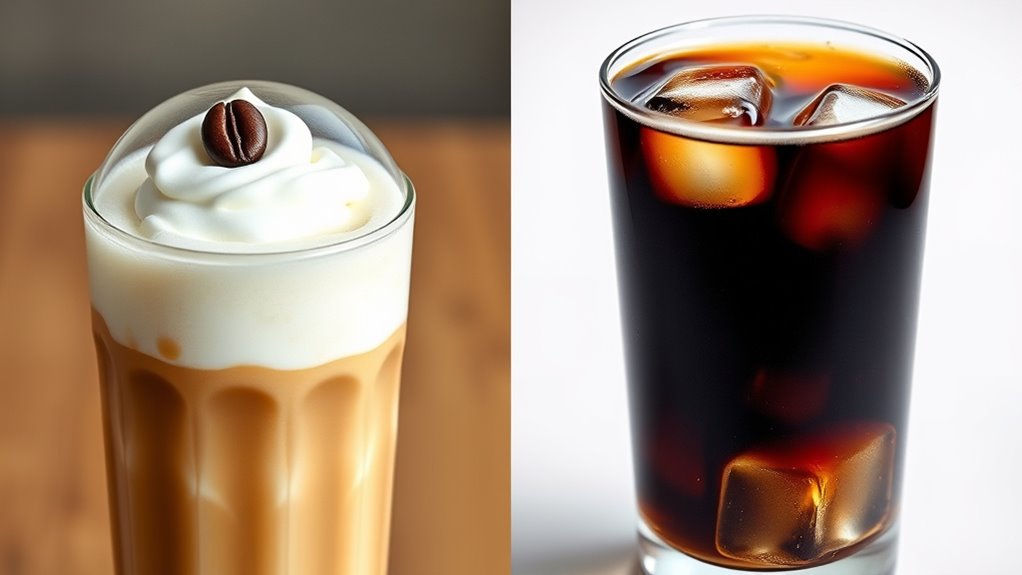
How you serve your iced coffee can make a big difference in its appeal, from the choice of glassware to the garnishes you add. You might prefer a layered look for visual impact or a blended presentation for a smoother appearance. Ultimately, the presentation and aesthetics help showcase each drink’s unique style and flavor. Using creative and unique planters can also enhance the overall visual appeal of your serving setup, making your beverage presentation more memorable.
Glassware and Garnishes
The choice of glassware and garnishes plays a crucial role in enhancing the visual appeal of your iced latte or cold brew. Selecting the right glassware styles can elevate your drink’s presentation, making it more inviting. Garnish choices also add flair and flavor, making each sip more enjoyable. Here are some ideas to consider:
- Use tall, clear glasses to showcase the drink’s color and layered effects.
- Opt for mason jars for a rustic, casual look.
- Add garnishes like a lemon wedge, mint sprig, or coffee bean to enhance aroma and aesthetics.
- Consider decorative straws or swizzle sticks for extra visual interest.
- To maintain the best quality over time, consider media guides that help you select the appropriate glassware and presentation accessories for your beverages.
Combining the right glassware styles with thoughtful garnish choices transforms a simple cold drink into a memorable experience.
Layered vs. Blended
Choosing between layered and blended presentations can considerably impact the visual appeal and drinking experience of your iced latte or cold brew. A layered appearance showcases distinct coffee and milk or flavor layers, creating an eye-catching look that highlights the drink’s ingredients. This method emphasizes contrast and elegance, making each sip feel more refined. On the other hand, a blended texture results in a smooth, uniform drink, often achieved by blending ice and ingredients into a cohesive mixture. This approach offers a consistent flavor with every sip and a invigorating, icy feel. Your choice depends on whether you prefer a striking visual with separate layers or a seamless, creamy consistency. Both styles enhance your drink’s presentation, but each offers a different sensory experience.
Presentation and Aesthetics
Presentation and aesthetics play an essential role in elevating your iced latte or cold brew experience. Visual appeal can make your drink more enticing and memorable. Consider these key elements:
- Use color coordination to match the drink with garnishes like fruit or syrup, enhancing visual harmony.
- Choose glassware that complements the beverage style—tall, clear glasses for cold brew or stylish mugs for lattes.
- Add branded elements, such as custom stir sticks or coasters, to reinforce your branding strategies.
- Garnish thoughtfully—whipped cream, a sprig of mint, or chocolate shavings—to create striking contrast and elegance.
- Incorporate color accuracy in your presentation, ensuring that the hues of your garnishes and drink components remain true and visually appealing.
Customization Options and Flavored Additions
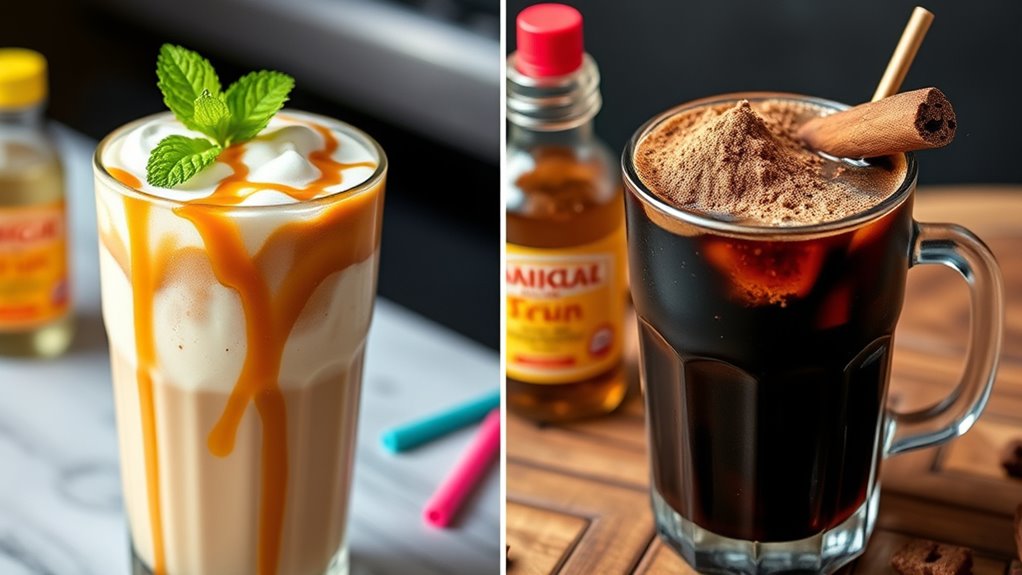
Both iced lattes and cold brews offer a wide range of customization options and flavored additions, allowing you to tailor each drink to your taste preferences. Flavor customization is simple—add syrups, spices, or extracts to enhance or change the profile. Cold brew’s versatility shines through with options like sweeteners, milk alternatives, and even infused flavors, making it easy to create a personalized beverage. Iced lattes also lend themselves well to flavoring, whether through flavored syrups or toppings like whipped cream and cinnamon. These options let you craft a drink that suits your mood or diet, whether you prefer a rich, sweet treat or a more subtle, invigorating sip. Incorporating aromatic essential oils can further elevate your drink experience, adding natural flavor and aroma notes. Overall, both drinks provide the flexibility to experiment and make each cup uniquely yours.
Nutritional Considerations and Calories
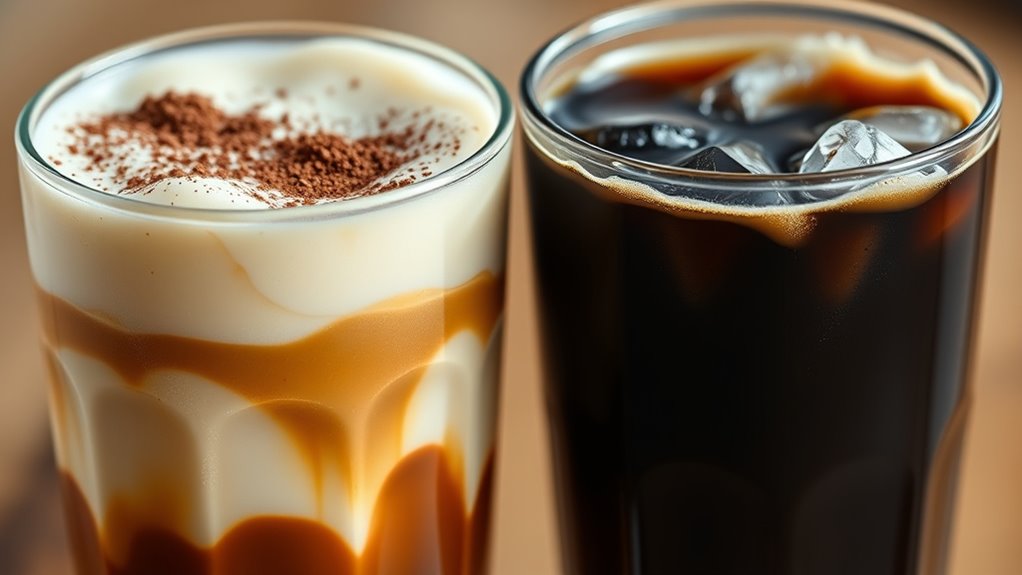
When comparing iced lattes and cold brews, you’ll notice differences in calorie content and added sugars. Cold brew often has fewer calories and less sugar, especially if you avoid flavored syrups. It’s helpful to look at the nutritional info to choose the option that fits your dietary goals. Additionally, opting for natural organic ingredients can further reduce unnecessary additives and enhance health benefits.
Calorie Content Differences
Understanding the calorie content of iced lattes and cold brews is essential when choosing your coffee beverage, especially if you’re mindful of your daily intake. Generally, iced lattes tend to have higher calorie content due to added milk and sweeteners, while cold brews are often lower in calories. Here’s what to contemplate:
- Iced lattes usually contain 150-250 calories per serving, depending on milk and syrup added.
- Cold brew black can have as little as 5-15 calories, making it a low-calorie option.
- Sugar levels considerably impact calorie content, with flavored or sweetened lattes increasing your intake.
- Opting for unsweetened versions or minimal milk can help manage your calorie and sugar intake more effectively.
Sugar and Additive Levels
Since added sugars and flavorings considerably influence the nutritional profile of your coffee, paying attention to these additives can help you make healthier choices. Iced lattes often contain higher sugar levels because flavored syrups and sweetened milk are common additions, increasing additive amounts and calorie content. Cold brew, on the other hand, typically has minimal or no added sugars, making it a lower-calorie option if you skip flavored syrups. Be mindful of what you add—syrups, creamers, and sweeteners can markedly boost sugar levels and additive amounts. Opting for unsweetened versions or reducing the amount of added ingredients allows you to enjoy your coffee without unnecessary calories or sugar spikes. Knowing what’s in your drink helps you stay aligned with your health goals.
Nutritional Value Comparison
Choosing between an iced latte and cold brew often comes down to their nutritional profiles and calorie counts. When doing a calorie comparison, cold brew generally has fewer calories due to less added milk and sugar. An ingredient analysis reveals that:
- Iced lattes contain more calories mainly from milk and sweeteners.
- Cold brew’s lower calorie count stems from its concentration and minimal additives.
- Nutritional value varies widely based on ingredients like milk type and syrup use.
- For a healthier choice, consider unsweetened cold brew or a skim milk latte.
Ideal Drinking Occasions and Pairings
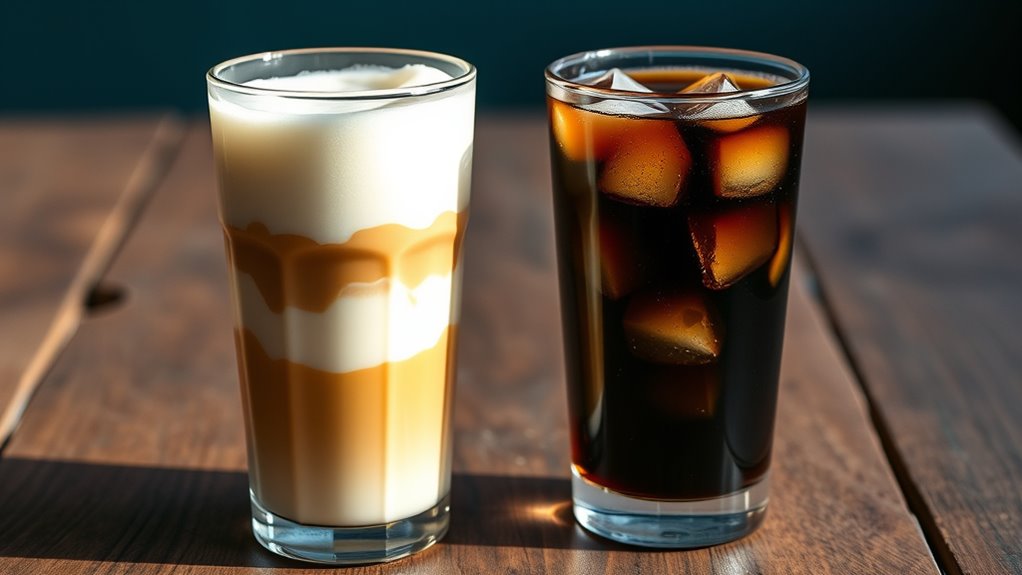
Whether you’re grabbing a quick pick-me-up in the morning or relaxing on a weekend afternoon, iced lattes and cold brews each shine in different settings. If you’re seeking a summer refreshment that’s smooth and slightly creamy, an iced latte pairs perfectly with breakfast or a midday snack. Its balanced flavor makes it ideal for a casual coffee break. On the other hand, cold brew’s bold, robust profile makes it a great choice for a leisurely afternoon or outdoor activity, especially if you want a strong caffeine kick. It pairs well with hearty desserts or even a light brunch. Both drinks are versatile, but your choice depends on whether you prefer a creamy, mellow experience or a concentrated, invigorating brew.
Shelf Life and Storage Tips

To keep your iced latte and cold brew fresh and flavorful, proper storage is essential. Use airtight storage containers to preserve shelf stability and prevent oxidation. Here are four tips to maximize freshness:
- Store in airtight containers to prevent flavor loss and contamination.
- Keep cold brew refrigerated at or below 40°F, ideally in glass bottles or sealed pitchers.
- Consume within 24-48 hours for ideal flavor; iced lattes are best enjoyed within the same day.
- Avoid storing in the door of the fridge, where temperature fluctuations occur.
Cost and Accessibility Factors
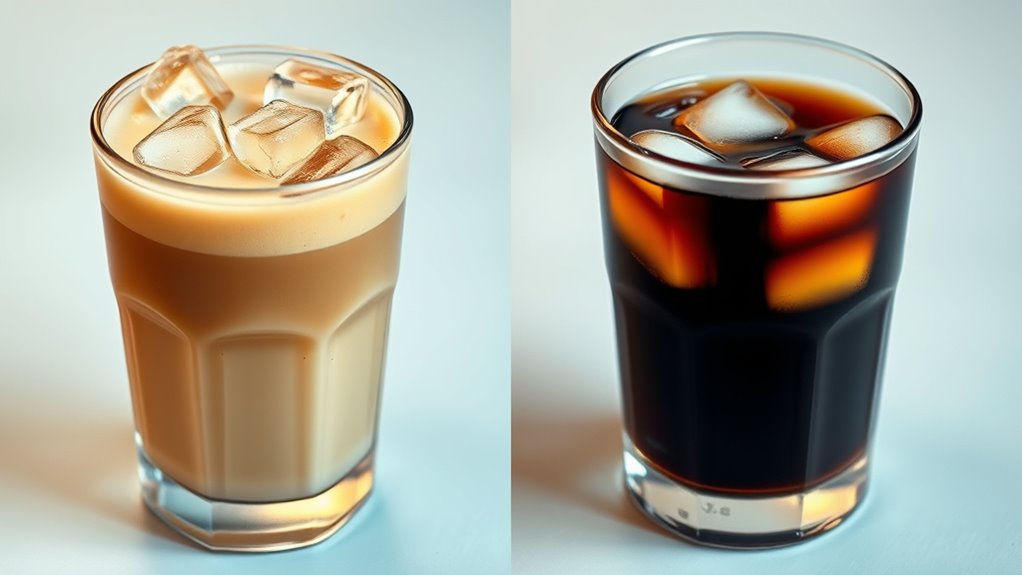
The cost and accessibility of iced lattes and cold brew can markedly influence your choice. A cost comparison shows that iced lattes usually cost more due to added ingredients like milk and syrups, plus the time involved in preparation. Cold brew, on the other hand, often requires a larger initial investment in equipment and takes time to brew, which some cafes might not offer easily. Accessibility challenges also play a role; you may find cold brew less available at smaller coffee shops or convenience stores, while iced lattes are more widely accessible. If affordability and convenience are priorities, cold brew might be harder to get regularly, whereas iced lattes are generally easier to find but can add up in cost over time.
Frequently Asked Questions
Which Beverage Is More Environmentally Friendly to Produce?
You’ll find cold brew tends to be more eco-friendly to produce because it often requires less energy and water during brewing. Opt for coffee brands that prioritize sustainable farming practices and use eco-friendly packaging to lessen environmental impact. Iced lattes, with added milk and more packaging, can have a bigger footprint. Choosing cold brew from sustainable sources helps you enjoy your coffee while supporting greener practices.
How Do Iced Latte and Cold Brew Affect Dental Health?
Imagine your tooth enamel as a fortress; cold brew’s lower acidity helps protect it, while iced lattes, often sweeter and more acidic, can weaken it over time. Oral acidity from frequent consumption of these beverages can erode enamel, increasing sensitivity. To safeguard your dental health, limit sugary add-ins and enjoy water afterward. Staying mindful of acidity levels keeps your smile strong, just like a fortress standing tall.
Are There Any Health Risks Associated With Cold Brew’s Higher Caffeine?
Yes, the higher caffeine in cold brew can pose health risks if you’re caffeine sensitive. Consuming too much may lead to increased heart rate, anxiety, or sleep issues. To stay safe, monitor your caffeine intake and practice health precautions like staying hydrated and avoiding it late in the day. If you notice adverse effects, cut back or consult a healthcare professional to prevent potential health problems.
Can I Make Iced Latte or Cold Brew at Home Without Special Equipment?
You can definitely make iced lattes or cold brew at home without special equipment, debunking the myth that it’s complicated. DIY brewing is straightforward—use a jar or pitcher for cold brew, steep coarsely ground coffee in cold water overnight, then strain. For an iced latte, brew strong coffee or espresso, chill it, then add milk and ice. Customize flavors easily to suit your taste, all without fancy gadgets.
How Do Regional Coffee Preferences Influence Iced Latte and Cold Brew Styles?
Regional flavor and cultural influences shape how you enjoy iced lattes and cold brews. In some areas, you might prefer a sweeter, creamier iced latte reflecting local tastes, while others favor the bold, smooth profile of cold brew influenced by regional coffee traditions. These preferences influence brewing methods, flavor additions, and presentation styles, making each style uniquely suited to local palates. Embrace these cultural nuances to enhance your coffee experience.
Conclusion
Whether you prefer the creamy richness of an iced latte or the smooth, bold flavor of cold brew, knowing their differences helps you choose the perfect brew for any moment. Did you know cold brew contains 70% more caffeine per ounce than traditional iced coffee? With this knowledge, you can enjoy your favorite iced drink mindfully, whether you’re craving an energizing boost or a revitalizing treat. Cheers to making informed coffee choices every time!
